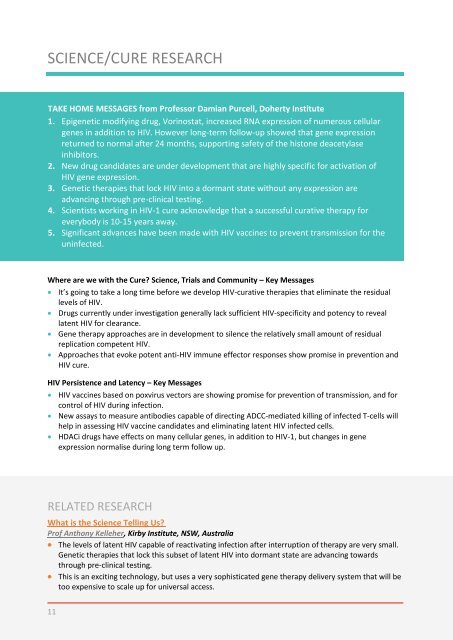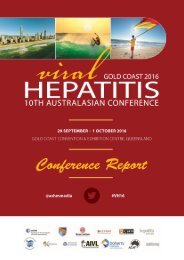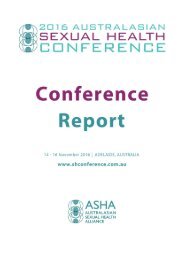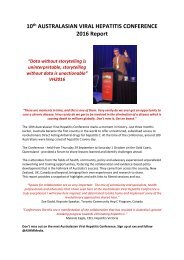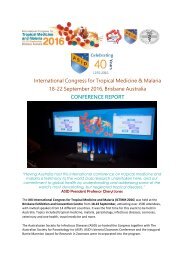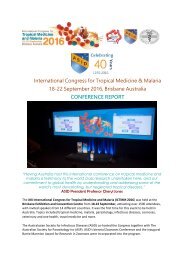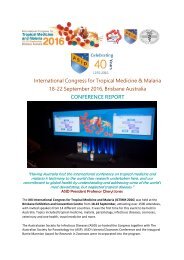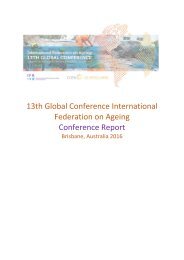AUSTRALASIAN HIV CONF REPORT 2016_FINAL
The Australasian HIV & AIDS Conference, run by ASHM, presents new and innovative research from across the Australasian HIV sector. Delegates include researchers, clinicians, policy makers, community organisations and activists. This 2016 Conference Report provides a collection of key learnings, with links to abstracts and presentations.
The Australasian HIV & AIDS Conference, run by ASHM, presents new and innovative research from across the Australasian HIV sector. Delegates include researchers, clinicians, policy makers, community organisations and activists. This 2016 Conference Report provides a collection of key learnings, with links to abstracts and presentations.
Create successful ePaper yourself
Turn your PDF publications into a flip-book with our unique Google optimized e-Paper software.
SCIENCE/CURE RESEARCH<br />
TAKE HOME MESSAGES from Professor Damian Purcell, Doherty Institute<br />
1. Epigenetic modifying drug, Vorinostat, increased RNA expression of numerous cellular<br />
genes in addition to <strong>HIV</strong>. However long-term follow-up showed that gene expression<br />
returned to normal after 24 months, supporting safety of the histone deacetylase<br />
inhibitors.<br />
2. New drug candidates are under development that are highly specific for activation of<br />
<strong>HIV</strong> gene expression.<br />
3. Genetic therapies that lock <strong>HIV</strong> into a dormant state without any expression are<br />
advancing through pre-clinical testing.<br />
4. Scientists working in <strong>HIV</strong>-1 cure acknowledge that a successful curative therapy for<br />
everybody is 10-15 years away.<br />
5. Significant advances have been made with <strong>HIV</strong> vaccines to prevent transmission for the<br />
uninfected.<br />
Where are we with the Cure? Science, Trials and Community – Key Messages<br />
It’s going to take a long time before we develop <strong>HIV</strong>-curative therapies that eliminate the residual<br />
levels of <strong>HIV</strong>.<br />
Drugs currently under investigation generally lack sufficient <strong>HIV</strong>-specificity and potency to reveal<br />
latent <strong>HIV</strong> for clearance.<br />
Gene therapy approaches are in development to silence the relatively small amount of residual<br />
replication competent <strong>HIV</strong>.<br />
Approaches that evoke potent anti-<strong>HIV</strong> immune effector responses show promise in prevention and<br />
<strong>HIV</strong> cure.<br />
<strong>HIV</strong> Persistence and Latency – Key Messages<br />
<strong>HIV</strong> vaccines based on poxvirus vectors are showing promise for prevention of transmission, and for<br />
control of <strong>HIV</strong> during infection.<br />
New assays to measure antibodies capable of directing ADCC-mediated killing of infected T-cells will<br />
help in assessing <strong>HIV</strong> vaccine candidates and eliminating latent <strong>HIV</strong> infected cells.<br />
HDACi drugs have effects on many cellular genes, in addition to <strong>HIV</strong>-1, but changes in gene<br />
expression normalise during long term follow up.<br />
RELATED RESEARCH<br />
What is the Science Telling Us?<br />
Prof Anthony Kelleher, Kirby Institute, NSW, Australia<br />
The levels of latent <strong>HIV</strong> capable of reactivating infection after interruption of therapy are very small.<br />
Genetic therapies that lock this subset of latent <strong>HIV</strong> into dormant state are advancing towards<br />
through pre-clinical testing.<br />
This is an exciting technology, but uses a very sophisticated gene therapy delivery system that will be<br />
too expensive to scale up for universal access.<br />
11


